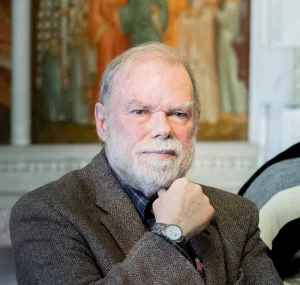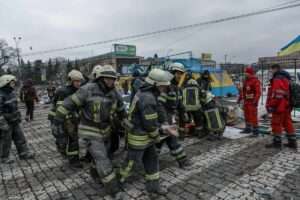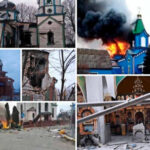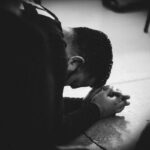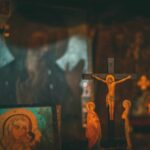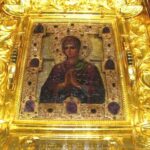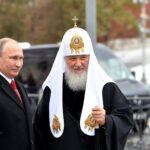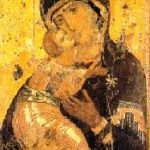News Reports
Patriarch Bartholomew and Pope John Paul meet in Rome
Pope John Paul II and Patriarch Bartholomew met in Rome in late June and promised to promote church unity.
Pope John Paul expressed regret for the crusaders' plundering of Constantinople -- now Istanbul -- in 1204 saying it was one of the "painful facts of the past" that had aggravated relations between the Catholic and Orthodox churches.
"How can we not also share, eight centuries later, the indignation and pain that, upon hearing the news of all that happened, [the then] Pope Innocent III had expressed immediately?" noted the Pope in his address to Bartholomew.
Bartholomew's visit marked the anniversary of the meeting in 1964 of Pope Paul VI and Patriarch Athenagoras I, the first such meeting after centuries of bitter separation between the church in Rome and Orthodox churches. Paul and Athenagoras followed the 1964 meeting by annulling mutual excommunications that dated back to the Great Schism of 1054.
In 1979, John Paul visited the Patriarchate of Constantinople. Soon afterwards a Joint International Commission for Theological Dialogue was created.
In recent years, however, tensions between the two churches had arisen over the issue of Eastern-rite Catholics.
A meeting of the dialogue commission in the US city of Baltimore in 2000 failed to reach any agreement on the matter and the differences were great enough to freeze any further meetings of the body.
"May the theological dialogue, through the Mixed Commission, remain to this end an important instrument," John Paul noted. "Because of this I desire that it be reactivated as soon as possible."
Bartholomew reaffirmed his willingness to continue the dialogue but warned that it "can fluctuate, because of difficulties that have accumulated during the history of the long division. Certain actions provoked the suspension or were an obstacle to the progress of dialogue."
At a Mass conducted by John Paul, Bartholomew stated that problems "accumulated over 900 years" could not be overcome in 40. Still, he expressed hope that one day the two "sister" churches would be able again "to commune from the same chalice."
As a gesture of good will, the Vatican has given the Church of St. Theodore on Rome's Palatine Hill to Rome's Greek Orthodox community.
At the end of the visit, John Paul accepted an invitation from Bartholomew to visit Istanbul.
Korean Orthodox starts dialogue with Orthodox group in N. Korea
The week of April 19th was a momentous one for the Orthodox Church in Korea. The bishop and a senior priest went to North Korea to initiate a dialogue with leaders of the recently formed Orthodox community for the capital city of Pyung-Yang. At the same time, the Synod of the Patriarchate of Constantinople elevated the Church in Korea to a separate Metropolis and the bishop to a Metropolitan.
From April 20 to 22, Bishop Sotirios Trambas, who has served in Korea as a missionary priest from Greece since 1975, and Protopresbyter Daniel Na, pastor of St. Paul Orthodox Church in Incheon, visited North Korea where they met with Il Jin Huh (George) and Chul Kim (Peter), who head the society building the Holy Trinity Orthodox Church in Dong-Baik Dong, Pyung-Yang City, to discuss cooperation. The church is due to open in 2005.
Four North Koreans are now in Russia studying to become priests.
Founded by Russian missionaries in 1900, the Orthodox Church in Korea maintained the faith despite difficult times. The Japanese occupation of Korea after the Russo-Japanese War, World War II, and especially the Korean War caused great hardships for the Church. Buildings were destroyed and clergy and laity were scattered and in some cases captured and taken to prison camps, never to return.
New church at place of mass martyrdom in Russia
In May 10,000 Orthodox Christians gathered for a Liturgy conducted by Patriarch Alexis at Moscow's Butovo range. About 30,000 people, mainly Muscovites, were executed at the Butovo range during the Stalinist era. About a thousand of them are believed to have suffered for their loyalty to the Orthodox Church.
"The range in Butovo became a symbol of Russia's sufferings, our national Golgotha," the patriarch said. The service was attended by a delegation from the Russian Orthodox Church Outside Russia led by Metropolitan Laurus.
"We especially keenly feel the pain of the separation of the Russian people caused by the revolution and the bloody civil war. Here we are regaining confidence that this wound will be healed by the sun of God's truth," Alexis said, adding that he hopes the tragic division within the Russian Church will soon be ended.
In 1996, a wooden church was built at the Butovo range to commemorate 20th century Russian martyrs. At the service, Patriarch Alexis II and Metropolitan Laurus laid a stone in the foundation of a brick church that is to be built at the range.
Serbian church plan closer ties with Catholics
Serbian Orthodox leaders have pledged closer cooperation with the Catholic Church after inaugurating contacts with the Vatican.
"We must be aware of the responsibility we bear," Patriarch Pavle told participants at a Belgrade meeting of the Council of European Roman Catholic Bishops Conferences on June 12. "If we remain solely at the level of speaking and writing, we will be like a tree with beautiful leaves but without fruit."
A press statement said closer inter-church contacts "disproved the position of atheist circles that churches are a divisive factor in society," and would further "the real spiritual unification of Europe."
Orthodox and Catholic bishops from Serbia-Montenegro held a first meeting in April 2003, two months after a Serbian Orthodox delegation visited the Vatican, while a delegation from Belgrade University's Orthodox Theology Faculty also visited Rome's Pontifical Lateran University in June to discuss theological cooperation and student exchanges.
A Serbian church communique said the Rome visit was the faculty's first international initiative since its reintegration into the university, and was intended to encourage "deeper understanding of the church's mission in the modern world." [ENI]
Bartholomew restores ties with Greek Church
Ecumenical Patriarch Bartholomew restored ties with the head of the Greek Church in June after a bitter dispute over control of dioceses in parts of Greece. Relations with Archbishop Christodoulos had been suspended April 30 after Christodoulos appointed three bishops in northern Greece without approval.
Following intervention by the Greek government, Bartholomew's Holy Synod said it agreed to restore ties with Christodoulos. It cited a recent decision by the Greek Church recognizing Bartholomew's oversight of the dioceses.
The territories in dispute -- which include Thessaloniki, Greece's second-largest city -- were part of the Ottoman Empire for nearly 100 years after Greece won its independence.
They were handed over to Athens to run in 1928, but titular control still belongs to the Ecumenical Patriarch.
Turkish Christians return to abandoned villages
The ancient Syriac Orthodox monastery outside Mardin in southeastern Turkey is praying for a brighter future as Christians, forced out of their ancestral lands by economic hardship and the Kurdish insurgency, start trickling back to their villages.
"It is our pleasure to have our people back from different parts of the world," said Archbishop Filuksinos Saliba Ozmen at the Deyrulzafaran monastery, which dates back to the fifth century and sits on a bluff overlooking an extensive plain. "By the grace of God, they are coming back. Otherwise, we would lose everything, the entire community."
The Syriac Orthodox community numbered some 50,000 to 60,000 members in southeastern Turkey in the 1960s. Many left for Europe in the 1970s for economic reasons. Emigration to countries in the west ballooned amid heavy fighting between the army and Kurdish rebels seeking self-rule in the mainly Kurdish southeast. "We were caught in the middle," Ozmen said. The community now numbers 20,000-25,000. Most of them now live in Istanbul.
Recently some Syriac Orthodox families in Europe decided they would try their luck and return to villages they had abandoned, as the insurgency has almost died out after rebels declared a unilateral cease-fire and took refuge in neighboring Iraq in 1999.
Ozmen explained that of 12 Syriac villages abandoned in the region, only Marbobo had been rebuilt and resettled. Reconstruction is under way in two other villages, Kafro and Arbo.
"The authorities are helping us with getting water and electricity to the villages. We are planning to receive some young families," said Ozmen. "If we get 5 percent of the Syriac community back, it would not be bad."
Georgian Church may resume collaboration with WCC
The head of the Georgian Orthodox Church has expressed his willingness to resume collaboration with the World Council of Churches following the first meeting of senior staff of the ecumenical body with the leadership of the church since its withdrawal from WCC in 1997.
Catholicos-Patriarch Ilia II confirmed his church's interest in comments made following a meeting with a WCC staff delegation headed by WCC deputy general secretary Georges Lemopoulos in Tbilisi, Georgia. Accompanying Lemopoulos on the 27-29 June visit to Georgia were WCC staff members Sylvia Raulo and Tamara Grdzelidze. Among other issues, the church leaders expressed their interest in collaborating in the areas of social witness and service of the churches, as well as in response to the challenges of globalization and European integration.
The three-million member Georgian Orthodox Church withdrew from membership in the WCC and other ecumenical organizations in 1997 after criticism of WCC orientations, and citing internal opposition to ecumenical relations. In 1998, the WCC set up a Special Commission on Orthodox participation in the WCC which sought to address some of the concerns articulated by Orthodox member churches. The report of the Special Commission was the main focus of discussion during a meeting with members of the Georgian Orthodox Theological Commission and with members of the Holy Synod.
"The meeting confirmed that there is a mutual willingness to renew dialogue and cooperation, without ignoring the significant differences that persist," Lemopoulos said, even though some sections of the Georgian Orthodox Church continue to express opposition to ecumenical contacts.
The Georgian Orthodox Church joined the WCC in 1961, and Catholicos-Patriarch Ilia II served as one of the presidents of WCC between 1983 and 1991.
Decani Monastery added to UNESCO's Heritage List
On July 2, 2004 the UNESCO World Heritage Committee added Decani Monastery in Kosovo to UNESCO's World Heritage List. It is a first cultural monument on the territory of the Serbian province of Kosovo inscribed on the list.
Visoki Decani Monastery was built from 1327 to 1335. It represents the last important phase of Byzantine-Romanesque architecture in the region and is the largest of all medieval Balkan churches. It contains exceptional, well-preserved Byzantine icons covering practically the entire interior of the church with over 1,000 individual depictions of saints. It also has numerous Romanesque sculptures.
The original marble floor is preserved, as is the interior furniture, and the main 14th century iconostasis.
A Quicktime presentation of Decani: www.kosovo.com/panoramamap.html.
Ultrasound scans reveal the life of unborn children
A new type of ultrasound scan has produced vivid pictures of a 12 week-old foetus "walking" in the womb. The new images also show foetuses yawning and rubbing their eyes.
The scans, pioneered by Professor Stuart Campbell at London's Create Health Clinic, are much more detailed than conventional ultrasound. Campbell has compiled a book of images called Watch Me Grow.
Conventional ultrasound produces 2D images of the developing foetus. These are useful for helping doctors to measure and assess the growth of the foetus, but convey little information about behavior.
Campbell says his work has been able to show for the first time that the unborn baby engages in complex behavior from an early stage of its development. "This is a new science for understanding and mapping out the behavior of the baby," he told reporters. "Maybe in the future it will help us understand and diagnose genetic disease, maybe even conditions like cerebral palsy which puzzles the medical profession as to why it occurs."
The images show that from 12 weeks, unborn babies can stretch, kick and leap around the womb, well before the mother can feel movement; from 18 weeks, they can open their eyes although most doctors thought eyelids were fused until 26 weeks; from 26 weeks, they appear to exhibit a whole range of typical baby behavior and moods, including scratching, smiling, crying, hiccoughing, and sucking. Until recently it was thought that smiling did not start until six weeks after birth. [news.bbc.co.uk]

